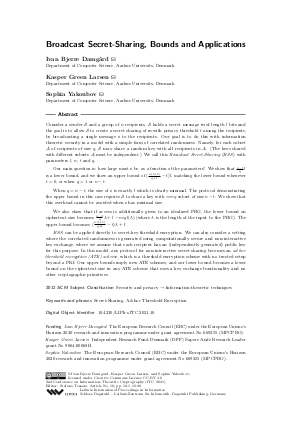Broadcast Secret-Sharing, Bounds and Applications
Authors Ivan Bjerre Damgård, Kasper Green Larsen, Sophia Yakoubov
-
Part of:
Volume:
2nd Conference on Information-Theoretic Cryptography (ITC 2021)
Part of: Series: Leibniz International Proceedings in Informatics (LIPIcs)
Part of: Conference: Conference on Information-Theoretic Cryptography (ITC) - License:
 Creative Commons Attribution 4.0 International license
Creative Commons Attribution 4.0 International license
- Publication Date: 2021-07-19
File

PDF
LIPIcs.ITC.2021.10.pdf
- Filesize: 0.74 MB
- 20 pages
Document Identifiers
Subject Classification
ACM Subject Classification
- Security and privacy → Information-theoretic techniques
Keywords
- Secret-Sharing
- Ad-hoc Threshold Encryption
Metrics
- Access Statistics
-
Total Accesses (updated on a weekly basis)
0Document
0Metadata
Abstract
Consider a sender 𝒮 and a group of n recipients. 𝒮 holds a secret message 𝗆 of length l bits and the goal is to allow 𝒮 to create a secret sharing of 𝗆 with privacy threshold t among the recipients, by broadcasting a single message 𝖼 to the recipients. Our goal is to do this with information theoretic security in a model with a simple form of correlated randomness. Namely, for each subset 𝒜 of recipients of size q, 𝒮 may share a random key with all recipients in 𝒜. (The keys shared with different subsets 𝒜 must be independent.) We call this Broadcast Secret-Sharing (BSS) with parameters l, n, t and q. Our main question is: how large must 𝖼 be, as a function of the parameters? We show that (n-t)/q l is a lower bound, and we show an upper bound of ((n(t+1)/(q+t)) -t)l, matching the lower bound whenever t = 0, or when q = 1 or n-t. When q = n-t, the size of 𝖼 is exactly l which is clearly minimal. The protocol demonstrating the upper bound in this case requires 𝒮 to share a key with every subset of size n-t. We show that this overhead cannot be avoided when 𝖼 has minimal size. We also show that if access is additionally given to an idealized PRG, the lower bound on ciphertext size becomes (n-t)/q λ + l - negl(λ) (where λ is the length of the input to the PRG). The upper bound becomes ((n(t+1))/(q+t) -t)λ + l. BSS can be applied directly to secret-key threshold encryption. We can also consider a setting where the correlated randomness is generated using computationally secure and non-interactive key exchange, where we assume that each recipient has an (independently generated) public key for this purpose. In this model, any protocol for non-interactive secret sharing becomes an ad hoc threshold encryption (ATE) scheme, which is a threshold encryption scheme with no trusted setup beyond a PKI. Our upper bounds imply new ATE schemes, and our lower bound becomes a lower bound on the ciphertext size in any ATE scheme that uses a key exchange functionality and no other cryptographic primitives.
Cite As Get BibTex
Ivan Bjerre Damgård, Kasper Green Larsen, and Sophia Yakoubov. Broadcast Secret-Sharing, Bounds and Applications. In 2nd Conference on Information-Theoretic Cryptography (ITC 2021). Leibniz International Proceedings in Informatics (LIPIcs), Volume 199, pp. 10:1-10:20, Schloss Dagstuhl – Leibniz-Zentrum für Informatik (2021)
https://doi.org/10.4230/LIPIcs.ITC.2021.10
BibTex
@InProceedings{damgard_et_al:LIPIcs.ITC.2021.10,
author = {Damg\r{a}rd, Ivan Bjerre and Larsen, Kasper Green and Yakoubov, Sophia},
title = {{Broadcast Secret-Sharing, Bounds and Applications}},
booktitle = {2nd Conference on Information-Theoretic Cryptography (ITC 2021)},
pages = {10:1--10:20},
series = {Leibniz International Proceedings in Informatics (LIPIcs)},
ISBN = {978-3-95977-197-9},
ISSN = {1868-8969},
year = {2021},
volume = {199},
editor = {Tessaro, Stefano},
publisher = {Schloss Dagstuhl -- Leibniz-Zentrum f{\"u}r Informatik},
address = {Dagstuhl, Germany},
URL = {https://drops.dagstuhl.de/entities/document/10.4230/LIPIcs.ITC.2021.10},
URN = {urn:nbn:de:0030-drops-143299},
doi = {10.4230/LIPIcs.ITC.2021.10},
annote = {Keywords: Secret-Sharing, Ad-hoc Threshold Encryption}
}
Author Details
Funding
- Damgård, Ivan Bjerre: The European Research Council (ERC) under the European Unions’s Horizon 2020 research and innovation programme under grant agreement No 669255 (MPCPRO).
- Larsen, Kasper Green: Independent Research Fund Denmark (DFF) Sapere Aude Research Leader grant No 9064-00068B.
- Yakoubov, Sophia: The European Research Council (ERC) under the European Unions’s Horizon 2020 research and innovation programme under grant agreement No 669255 (MPCPRO).
References
-
Shashank Agrawal, Payman Mohassel, Pratyay Mukherjee, and Peter Rindal. DiSE: distributed symmetric-key encryption. In Proceedings of the 2018 ACM SIGSAC Conference on Computer and Communications Security, pages 1993-2010, 2018.

- Dan Boneh and Mark Zhandry. Multiparty key exchange, efficient traitor tracing, and more from indistinguishability obfuscation. In Juan A. Garay and Rosario Gennaro, editors, CRYPTO 2014, Part I, volume 8616 of LNCS, pages 480-499. Springer, Heidelberg, August 2014. URL: https://doi.org/10.1007/978-3-662-44371-2_27.
-
Ronald Cramer, Ivan Damgård, and Yuval Ishai. Share conversion, pseudorandom secret-sharing and applications to secure computation. In Joe Kilian, editor, TCC 2005, volume 3378 of LNCS, pages 342-362. Springer, Heidelberg, February 2005.

- Vanesa Daza, Javier Herranz, Paz Morillo, and Carla Ràfols. Ad-hoc threshold broadcast encryption with shorter ciphertexts. Electron. Notes Theor. Comput. Sci., 192(2):3-15, May 2008. URL: https://doi.org/10.1016/j.entcs.2008.05.002.
-
Alfredo De Santis, Yvo Desmedt, Yair Frankel, and Moti Yung. How to share a function securely. In 26th ACM STOC, pages 522-533. ACM Press, May 1994.

-
Cécile Delerablée and David Pointcheval. Dynamic threshold public-key encryption. In David Wagner, editor, CRYPTO 2008, volume 5157 of LNCS, pages 317-334. Springer, Heidelberg, August 2008.

-
Sanjam Garg, Omkant Pandey, Akshayaram Srinivasan, and Mark Zhandry. Breaking the sub-exponential barrier in obfustopia. In Jean-Sébastien Coron and Jesper Buus Nielsen, editors, EUROCRYPT 2017, Part II, volume 10211 of LNCS, pages 156-181. Springer, Heidelberg, April / May 2017.

- Dennis Hofheinz, Tibor Jager, Dakshita Khurana, Amit Sahai, Brent Waters, and Mark Zhandry. How to generate and use universal samplers. In Jung Hee Cheon and Tsuyoshi Takagi, editors, ASIACRYPT 2016, Part II, volume 10032 of LNCS, pages 715-744. Springer, Heidelberg, December 2016. URL: https://doi.org/10.1007/978-3-662-53890-6_24.
- Fermi Ma and Mark Zhandry. Encryptor combiners: A unified approach to multiparty NIKE, (H)IBE, and broadcast encryption. Cryptology ePrint Archive, Report 2017/152, 2017. URL: http://eprint.iacr.org/2017/152.
- Leonid Reyzin, Adam Smith, and Sophia Yakoubov. Turning hate into love: Homomorphic ad hoc threshold encryption for scalable mpc. Cryptology ePrint Archive, Report 2018/997, 2018. URL: https://eprint.iacr.org/2018/997.
